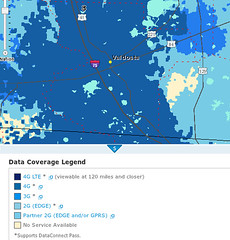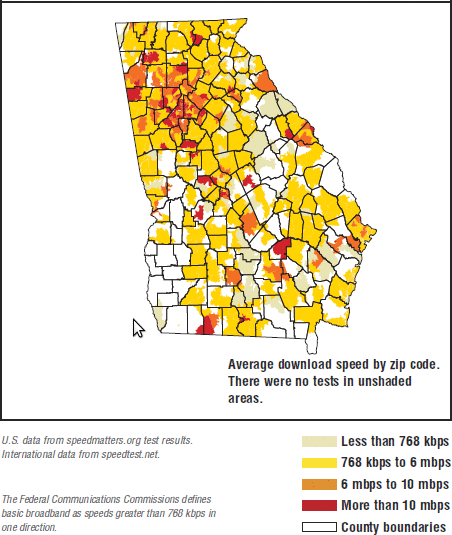How fast is
4G wireless Internet, anyway?
Mark Sullivan wrote for PCWorld 7 May 2012,
3G/4G Performance Map: Data Speeds for AT&T, Sprint, T-Mobile, and Verizon,
 We saw three major patterns in our 4G test results. In five cities
(Atlanta, Boston, Las Vegas, Los Angeles, and San Francisco), AT&T
swept the 4G upload and download competitions; in four (Denver, New
Orleans, San Jose, and Seattle), Verizon swept both; and in the
remaining four (Chicago, Dallas, New York, and Washington, D.C.),
AT&T won for downloads and Verizon prevailed for uploads. Notably,
in two of the cities where Verizon ruled (Denver and Seattle), AT&T
doesn’t offer 4G LTE service.
We saw three major patterns in our 4G test results. In five cities
(Atlanta, Boston, Las Vegas, Los Angeles, and San Francisco), AT&T
swept the 4G upload and download competitions; in four (Denver, New
Orleans, San Jose, and Seattle), Verizon swept both; and in the
remaining four (Chicago, Dallas, New York, and Washington, D.C.),
AT&T won for downloads and Verizon prevailed for uploads. Notably,
in two of the cities where Verizon ruled (Denver and Seattle), AT&T
doesn’t offer 4G LTE service.
And you’ll notice a pattern right away: they only tested big cities.
So your mileage may vary around here.
However, PCWorld’s observed average 4G speeds for
Verizon were 7.35 Mbps down and 5.86Mbps up,
and for AT&T 9.12Mbps down and 4.91Mpgs up.
Verizon’s
HomeFusion Broadband
web page claims:
HomeFusion Broadband* is a residential Internet solution that uses Verizon’s 4G LTE network to bring reliable, high-speed Internet service to customers with limited broadband options.
Features
-
Fast Internet access with average speeds of
5-12 Mbps download and 2-5 Mbps upload
-
Wi-Fi connectivity for up to 20 devices
-
Wired (Ethernet) connectivity for up to 4 devices
-
Up to 5 email accounts included
That’s faster than Mediacom and
way faster than AT&T’s alleged 3Mbps DSL I’m using at the moment,
which shows 3.5Mbps down and 0.38Mbps up.
Prices start at $60/month,
the same as for Verizon’s Mobile Broadband 5G, which
with EVDO typically does
around 1Mbps down and 0.7Mbps up
and
with 4G typically does 5Mbps down and 3Mbps up.
Why do these speeds matter?
Well, for video blogging, videos of a one hour meeting can take
8 hours to upload at 0.38 Mbps.
At 5Mbps they should take less than an hour.
That makes it a lot easier for LAKE to get you coverage of local events.
If you’re not video blogging, you still might like to be able to see
George Rhynes’ excellent video coverage of events in Lowndes, Brooks,
Lanier, and other counties.
And nevermind video:
a lot of people around here have no Internet access at all.
This would be one way to get it.
Some people around here already use Verizon’s mobile devices at home,
because otherwise they’re stuck with dialup.
Then there’s reliability.
I, for one, would like not to see ATM Cell Header Errors anymore,
nor the “page not found, retry?” errors every few minutes.
If you don’t know what those are, you probably don’t have AT&T DSL.
It’s sad that wireless might be more reliable than copper.
But I’m also glad about that because wireless doesn’t require running wires.
And did I mention 4G wireless appears to be faster?
-jsq
A comparison by Wireless Intelligence, a unit of the GSM Association, suggests that being in the biggest LTE market has not brought low prices to U.S. consumers.
















